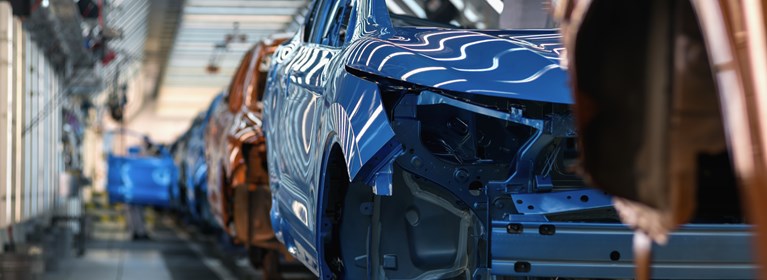Automated Automotive Parts Dipping System
Automotive Industry |
Power & Motion Technology |
By Magnetek |
Mar 15, 2005
Background
In automobile manufacturing, it is essential that the vehicles be properly painted, not only for aesthetic reasons, but also to increase the life of the automobiles. One method for reliably painting parts is the electro-static process. This process involves electrically charging the paint and the materials to be painted with opposite charges. Since opposite charges attract, paint only adheres to the intended products. The amount of paint that adheres to the parts is dependent upon the voltage applied and the amount of time the paint and parts are energized. This method of electro-static painting provides better overall coverage than traditional methods of painting, with little wasted paint.
One draw back to electro-static painting is the voltages applied can be as high as 700 VDC. With these high voltages, it is recommended that the area be clear of personnel while parts are being painted. Automating the process not only removes personnel from harms way, but also improves the consistency and overall efficiency of the application. The end solution for one automobile painting facility was to install a series of dip tanks that would first clean the parts and then paint them in an electro-static process. The system was initially designed to paint car and truck frames, but was soon modified to accept other auto parts as well. By varying the voltage applied and the amount of time parts are charged, the electro-static painting process is customized to meet the requirements for each individual part.
System Description
The automated electro-static painting system for this particular manufacturer consists of four identical dipping cranes working congruently over one tank line. The cranes are identical with the only variance occurring in the control programs running in their on-board Allen-Bradley ControlLogix processors. Each crane’s rigid mast contains two hoists that are controlled separately and synchronously by two Electromotive IMPULSE VG+ Series 2 vector drives. This allows the hoists to raise and lower the load evenly into and out of the tanks, and allows them to tilt in order to drain excess liquid from the parts before moving to the next tank. When too much liquid is moved between tanks, the tanks become contaminated, which requires that they are drained and cleaned, causing down time, lost productivity and increased chemical costs. The automatic tilting process reduces the amount of liquid moved between tanks, thus reducing system downtime and costs associated with cleaning the tanks. The bridge motions are controlled by Electromotive IMPULSE® G+ Series 2 Adjustable Frequency Drives. All four cranes communicate with an off board Allen-Bradley ControlLogix PLC mounted in a console enclosure. This off-board PLC is responsible for traffic control, interfacing to the conveyor and tank control systems, and communicating with an Allen-Bradley PanelView 1000 operator interface.
System Operation
The main operation of the crane system is fully automatic. Parts enter the system via a fork truck loading onto an entrance conveyor. The entrance conveyor transfers the parts onto a pre-treat carrier. When the pre-treat carrier is loaded, Dipping Crane #1 picks the carrier and processes it through a series of clean and rinse tanks. Dipping Crane #2 retrieves the carrier from the conditioner tank and proceeds to process it through phosphate, rinse and sealer tanks. Crane #3 then picks up the carrier from the sealer and unloads it onto a transfer conveyor, which transfers the parts to a paint carrier. The paint carrier then travels through the e-coat tanks, and back to the transfer conveyor. Finally Dipping Crane #4 retrieves the paint carrier from the transfer conveyor and processes it to the unload conveyor.
Each crane runs independently of the others. If a fault occurs on one crane, the other cranes continue to operate, unless the other cranes are unaware of the faulted crane’s position. The entire automated e-coat process consists of 16 tanks, 5 conveyor systems and 4 fully automated cranes that communicate information between the cranes, tanks and conveyors. Eight carriers typically run through the system at a time, with a 445 second cycle time per carrier.
An SBP2 pushbutton pendant station is used for manual operation of the cranes during maintenance conditions.
North America - EN





